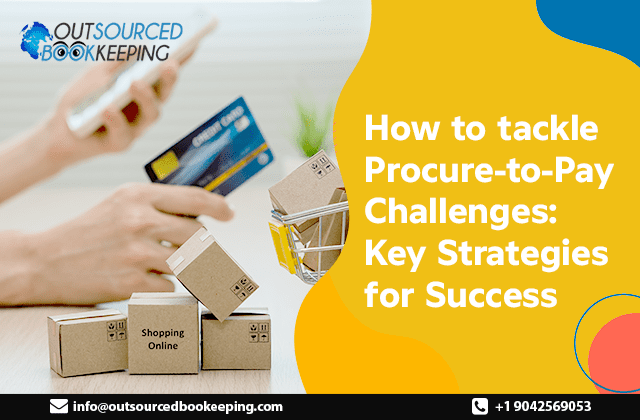Are you searching for ways to overcome P2P challenges? Well, your search ends here! It is essential to note that every business firm faces difficulties with Procure-to-Pay activities. From poor processes in procurement to uncontrolled spending, or supplier relations management, organizations must master the Procure-to-Pay process.
In this article, we will explore several important ways to overcome P2P challenges and enhance procurement and payment operations. From improving visibility and automation to encouraging supplier engagement, let’s discover practical strategies for achieving P2P initiatives’ purpose.

Mastering the Procure-to-Pay Cycle: The cornerstone of operational efficiency
Procure-to-pay cycle, also known as the P2P cycle, is a comprehensive process that depicts all the phases of purchasing in an organization. It covers all the processes starting from identification of procurement needs to payment to the supplier which includes sourcing, requisitioning, ordering, receiving, invoicing, and payment.
Businesses must manage this cycle effectively as this is one of the key aspects that can impact the supplier relations, cost, and operational efficiency. Moreover, automating procure-to-pay process offers a lot of benefits including:
- Decrease in maverick spend
- Increase in spending visibility
- Compliance with the procurement policies
- Efficient workflow
- Efficient supplier relationship management
- Performance management
- Increase cost savings through strategic sourcing and negotiation
Top 5 Ways to Overcome Procure To Pay Challenges
The following are some of the strategies that organizations can adopt to address procure-to-pay challenges and improve their procurement operations’ efficiency. Today, automation, optimization, and business practices contribute to the effectiveness of the organization by improving the procurement cycle. Here are the top 5 procurement best practices to overcome procure-to-pay challenges and streamline operations:
Automate Procure-to-Pay Processes
The existing procure-to-pay processes involve several activities that are mostly manual, and therefore, riddled with inefficiencies, errors, and delays. When the major steps of the P2P cycle are automated, the efficacy, reliability, and traceability of the entire process are significantly improved.
Requisitioning and ordering, accounts payable and invoices, approval, and even scheduling of payments, are all done automatically and efficiently, cutting down on time and excluding errors. It also enhances control over the adherence to the procurement policies and contracts, thus enhancing the procurement control and operational efficiency of spend management.Enhance Invoice Processing
Managing invoices and allocating payments to various suppliers is a critical process that contributes to the overall cash flow and supplier management. Smart AP solutions use technology to capture, match, and route invoices with perfect accuracy and without delay.
The automation of invoice processing helps to decrease the time required to process invoices, decrease the possibility of manual mistakes, and meet the supplier’s payment terms. More advanced features in invoice processing also enable more control and improved decision-making of the expenditure.
Optimize Purchase-to-Pay Automation
Purchase-to-pay automation is a means of automating procurement processes right from the time a purchase order is placed to the time it is paid. These solutions can range from automating the requisition creation to the approval of the requisition, the purchasing, and the subsequent payment, and all these can be done with the intent of shortening the cycle time and increasing the efficiency of the process.
To achieve such efficiency, purchase-to-pay automation should be optimized in order to improve visibility, control, and compliance at every stage of procurement. Improved workflow means improved supplier relations and a clear return on investment, overall saving costs in the process.
Utilize Accounts Receivable Services
The outsourcing of account receivables services can be useful for organizations to over P2P challenges. It ensures better cash flow control and decreased overdue receivables. Accounts receivable services facilitate billing, invoicing, and collections so that companies can receive money from customers in a timely manner.
Thus, outsourcing of receivables management activity can help organizations work more effectively with less financial risks and more efficient cash flows. Advanced accounts receivable services also help in understanding customer payment patterns and assisting in better credit management.
Strengthen Supplier Collaboration
Success in procurement and supply management also depends on collaborating with suppliers to manage an organization’s procure-to-pay cycle. Organizations should encourage tenders to build an effective relationship with the suppliers because this way the company saves costs, and time and minimizes risks.
Cooperative procurement partnerships with suppliers are essential in enhancing procurement strategies, contract agreements, and handling of concerns. Supplier portals offer various features such as real-time communication, document management, and performance tracking thus enhancing a business-to-supplier relationship and creating value.
Final Overview
Managing P2P challenges by use of strategies such as automation, adoption of technology, and working closely with the suppliers should be the focus of organizations to enable the achievement of a successful procurement.
When these measures are effectively adopted, companies stand to benefit from increased productivity, reduced costs, and increased profitability. For more expert advice, do contact the professionals at Outsourced Bookkeeping: your ultimate partner to overcome all procure-to-pay challenges!








